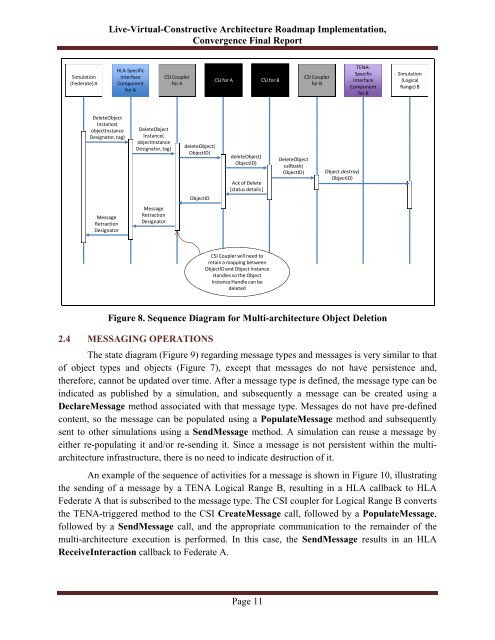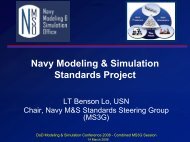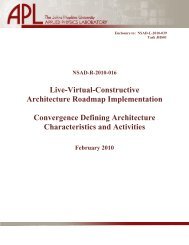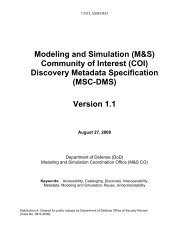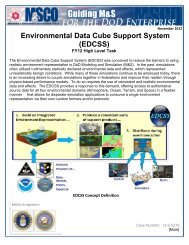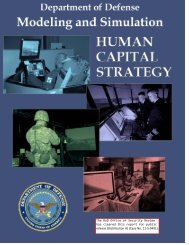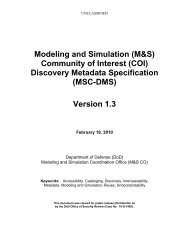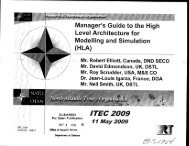LVCAR-I Convergence Final Report - Modeling & Simulation ...
LVCAR-I Convergence Final Report - Modeling & Simulation ...
LVCAR-I Convergence Final Report - Modeling & Simulation ...
You also want an ePaper? Increase the reach of your titles
YUMPU automatically turns print PDFs into web optimized ePapers that Google loves.
Live-Virtual-Constructive Architecture Roadmap Implementation,<br />
<strong>Convergence</strong> <strong>Final</strong> <strong>Report</strong><br />
<strong>Simulation</strong><br />
(Federate) A<br />
HLA‐Specific<br />
Interface<br />
Component<br />
for A<br />
CSI Coupler<br />
for A<br />
CSI for A<br />
CSI for B<br />
CSI Coupler<br />
for B<br />
TENA‐<br />
Specific<br />
Interface<br />
Component<br />
for B<br />
<strong>Simulation</strong><br />
(Logical<br />
Range) B<br />
DeleteObject<br />
Instance(<br />
objectInstance<br />
Designator, tag)<br />
DeleteObject<br />
Instance(<br />
objectInstance<br />
Designator, tag)<br />
deleteObject(<br />
ObjectID)<br />
ObjectID<br />
deleteObject(<br />
ObjectID)<br />
Ack of Delete<br />
[status details ]<br />
DeleteObject<br />
callback(<br />
ObjectID)<br />
Object.destroy(<br />
ObjectID)<br />
Message<br />
Retraction<br />
Designator<br />
Message<br />
Retraction<br />
Designator<br />
CSI Coupler will need to<br />
retain a mapping between<br />
ObjectIDand Object Instance<br />
Handles so the Object<br />
Instance Handle can be<br />
deleted<br />
Figure 8. Sequence Diagram for Multi-architecture Object Deletion<br />
2.4 MESSAGING OPERATIONS<br />
The state diagram (Figure 9) regarding message types and messages is very similar to that<br />
of object types and objects (Figure 7), except that messages do not have persistence and,<br />
therefore, cannot be updated over time. After a message type is defined, the message type can be<br />
indicated as published by a simulation, and subsequently a message can be created using a<br />
DeclareMessage method associated with that message type. Messages do not have pre-defined<br />
content, so the message can be populated using a PopulateMessage method and subsequently<br />
sent to other simulations using a SendMessage method. A simulation can reuse a message by<br />
either re-populating it and/or re-sending it. Since a message is not persistent within the multiarchitecture<br />
infrastructure, there is no need to indicate destruction of it.<br />
An example of the sequence of activities for a message is shown in Figure 10, illustrating<br />
the sending of a message by a TENA Logical Range B, resulting in a HLA callback to HLA<br />
Federate A that is subscribed to the message type. The CSI coupler for Logical Range B converts<br />
the TENA-triggered method to the CSI CreateMessage call, followed by a PopulateMessage,<br />
followed by a SendMessage call, and the appropriate communication to the remainder of the<br />
multi-architecture execution is performed. In this case, the SendMessage results in an HLA<br />
ReceiveInteraction callback to Federate A.<br />
Page 11


